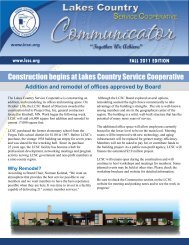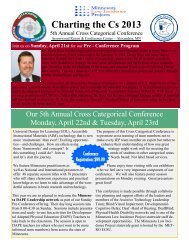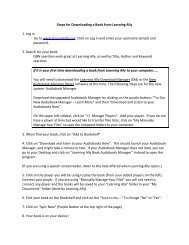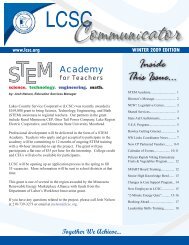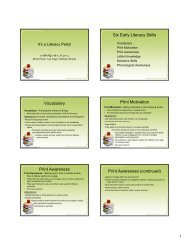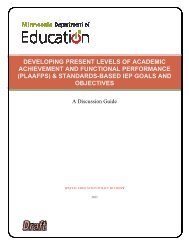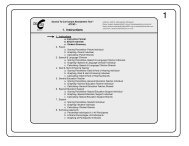Lesson Plan
Lesson Plan
Lesson Plan
Create successful ePaper yourself
Turn your PDF publications into a flip-book with our unique Google optimized e-Paper software.
<strong>Lesson</strong> <strong>Plan</strong><br />
Topic: Understanding how Motors and Generators Operate<br />
Subject: Tech. Ed.<br />
Title of <strong>Lesson</strong>: Motors and Generators Grade: 10-12<br />
Teacher Name/s: Tom Leuthner, Battle Lake School<br />
1. Learning Goal:<br />
Students will gain an understanding of how motors and generators operate by<br />
Constructing a working model of a fixed magnet DC motor.<br />
2. Objective:<br />
By constructing a fixed magnet DC motor, students will be able to:<br />
1. Identify and describe the components of a DC motor.<br />
2. Trouble Shoot and correct basic circuit faults.<br />
3. Use diagrams and text to explain the operation of a fixed magnet DC motor.<br />
Minnesota State Standards that are addressed in this lesson are:<br />
The nature of science and engineering: 3.1.1.1.1<br />
3.1.1.2.1<br />
3.1.1.2.2<br />
4.1.2.2.1<br />
4.1.2.2.2<br />
5.1.1.2.1<br />
6.1.3.1.1<br />
8.1.3.3.3<br />
9.1.2.2.2<br />
Physical Science 4.2.3.2.3<br />
6.2.3.2.2<br />
9.2.3.2.1<br />
9.2.3.2.5<br />
9P.2.3.2.3<br />
9P.2.3.2.4
3. Prior teacher preparation and knowledge of students:<br />
Teachers must collect the materials listed on the handout. A good resource for this<br />
material is www.kelvin.com for a complete list of materials; please reference the handout<br />
on constructing a Fixed Magnet DC Motor.<br />
Students will need a basic understanding of electrical charges. A good starting point is to<br />
watch a power point presentation on DC motor fundamentals. Another example would<br />
be to show the students an example of an electromagnet, and in so doing create a simple<br />
circuit using batteries, or a DC power supply.<br />
4. List of materials/resources.<br />
Small Magnets (4-6 per motor)<br />
Large Paper Clips<br />
Alligator clip test leads 2 per motor<br />
1/16” drill bit<br />
D size battery holder<br />
Wire cutters<br />
D sized Alkaline Dry Cell<br />
Clear Tape<br />
Exacto knives, 1 per group<br />
Needle Nose pliers<br />
Wooden Block approximately ¾” x 4” x 4”<br />
Enameled Magnet Wire 24-18 gauge approximately 24inches per motor<br />
Toilet Paper Rolls, or a Wooden Dowel of approximately the same diameter.<br />
5. <strong>Lesson</strong> Procedure<br />
Introduction:<br />
Review the handout on motor terminology.<br />
Watch the power point presentation on DC motor fundamentals.<br />
Review the handout on how to construct a fixed magnet DC motor.<br />
Exploring/Development<br />
Working individually, or in pairs, students will construct a fixed magnet DC motor.<br />
As students progress through the project, ask them to identify the various parts and<br />
the purpose they serve to allow the motor to operate. Students will be presented with<br />
various problem solving opportunities, encourage them to try there own ideas to reach<br />
the desired solution.<br />
Instructors should use their judgment, when dealing with students with special needs.<br />
Additional supervision or adaptations may be necessary. E.g. teacher aide must be<br />
present with student at all times during the activity to prevent injury.
Summarizing and Practice<br />
As students progress through the lesson, it’s best to use good questioning techniques<br />
to allow students the opportunity to think about the project as they are constructing it.<br />
Questions to ask may include:<br />
“What is the name of the part you are building”<br />
“What purpose does the part serve in the operation of an electric motor”<br />
“Can you think of a way to improve the performance of the part”<br />
At the completion of the project, have the students show their projects to other<br />
members of the class. Ask them what they learned about motors, and what methods,<br />
or problem solving skills they used to help it perform better.<br />
An excellent follow-up activity would be to explore the inner parts of an actual<br />
electric motor from a small appliance. See if students can identify the various parts.<br />
6. Assessment/Evaluation<br />
There are several ways to assess this lesson.<br />
1. Students are able to research and define the necessary terminology related to<br />
electric motors and generators.<br />
2. Students are able to construct a working model of a fixed magnet DC electric<br />
motor.<br />
3. Students are able to identify the parts and explain their purpose in an electric<br />
motor.<br />
4. Students will be required to pass a written test with at least 75% accuracy.
7. Reflection.<br />
In order for this lesson to be a success, students must have an understanding of how<br />
the project is assembled. This is best accomplished by reading through the<br />
instructions as a group first, then allowing the students to access their supplies.<br />
Another recommendation would be to build the project first ahead of time and find<br />
out what areas might need additional explanation, or problem solving.<br />
As a final measure of what the students have learned, students should be able to<br />
produce a working model of a fixed magnet DC motor, identify and explain the<br />
purpose of the various parts of the motor and pass a test with no less than 75%<br />
accuracy.<br />
“This workforce solution was funded by a grant awarded under Workforce Innovation in Regional Economic Development<br />
(WIRED) as implemented by the U.S. Department of Labor’s Employment and Training Administration. The solution was<br />
created by the grantee and does not necessarily reflect the official position of the U.S. Department of Labor. The Department of<br />
Labor makes no guarantees, warranties, or assurances of any kind, express or implied, with respect to such information,<br />
including any information on linked sites and including, but not limited to, accuracy of the information or its completeness,<br />
timeliness, usefulness, adequacy, continued availability, or ownership. This solution is copyrighted by the institution that<br />
created it. Internal use by an organization and/or personal use by an individual for non‐commercial purposes is permissible.<br />
All other uses require the prior authorization of the copyright owner.”





